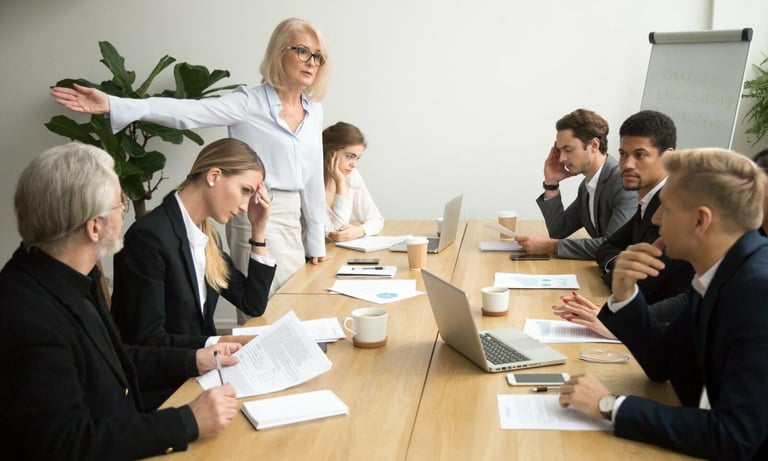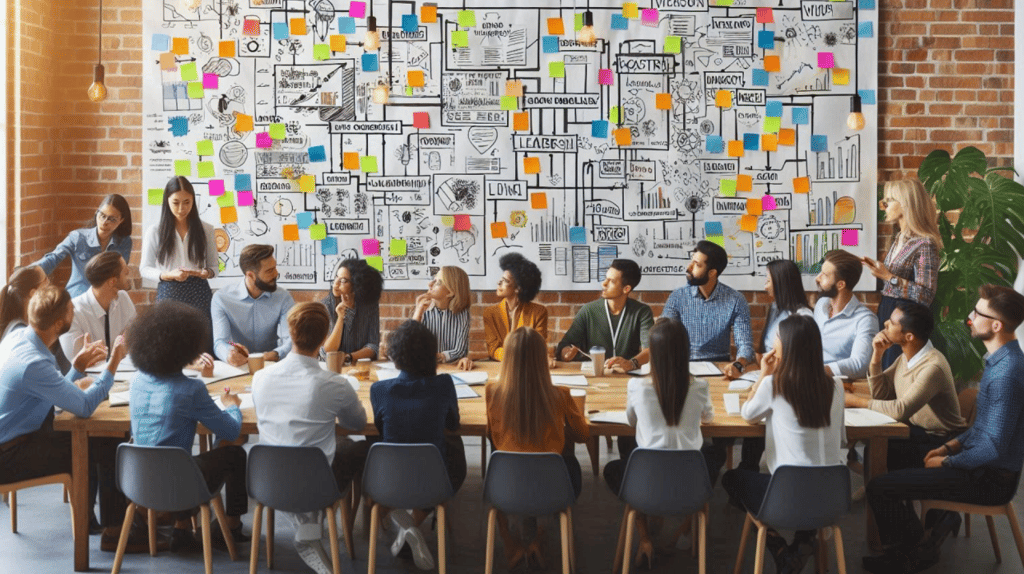Leadership Communication


"The art of communication is the language of leadership." James Humes


Empathy is Key in Professional Leadership In today's fast-paced business environment, the role of empathy in leadership cannot be overstated. As professionals in the C-suite, it is imperative to recognize that effective leadership extends beyond strategic decision-making and financial acumen. Empathy fosters a culture of understanding and collaboration, which is essential for innovation and long-term success. Empathy allows leaders to connect with their teams on a deeper level, promoting an environment where employees feel valued and understood. This connection not only boosts morale but also enhances employee engagement and productivity. When leaders demonstrate genuine concern for the well-being of their staff, it cultivates trust and loyalty, vital elements for organizational resilience. Moreover, empathetic leadership can drive better customer relations. Understanding the needs and perspectives of clients leads to more tailored solutions and improved service delivery. Therefore, leaders who practice empathy are not only enhancing internal dynamics but also contributing to superior external relationships. As C-suite executives, the challenge lies in balancing empathy with the demands of leadership. It requires a commitment to active listening and the cultivation of emotional intelligence. By prioritizing empathy in our leadership approach, we set the stage for a thriving organizational culture that values individuals and drives collective success. In conclusion, integrating empathy into our leadership practices is essential for fostering a positive workplace environment and achieving business excellence. Let us embrace this quality as a cornerstone of our leadership philosophy, guiding our organizations toward greater innovation and success. For further insights or discussions on implementing empathetic leadership in your organization, please feel free to reach out at [item].
The Role of Leadership in Fostering Communication:
Setting Clear Communication Expectations: Ensuring everyone is on the same page and knows what is expected.
Leading by example: Practicing open, honest communication and actively listening to the team.
Promoting a culture of open dialogue: Creating a safe space for employees to share ideas and concerns.
Providing Training and Resources: Equipping employees with the skills and tools they need to communicate effectively.
Recognizing and Rewarding Effective Communication: Encouraging and reinforcing positive communication behaviors.
Strategic communication for leaders involves crafting and delivering messages intentionally to achieve specific goals, build relationships, and influence behavior. It's about more than just conveying information; it's about shaping perceptions and aligning an organization's efforts. Effective leaders use strategic communication to convey a clear vision, manage change, and build trust. Effective leadership communication is the cornerstone of a successful organization. It goes beyond simply conveying information; it's about inspiring, motivating, and connecting with employees on a deeper level. Leaders who communicate effectively build trust, foster collaboration, and ensure everyone is working towards a shared vision. This involves clear articulation of goals and expectations, active listening to understand concerns and perspectives, and providing constructive feedback that empowers individuals to grow and improve. Moreover, effective leadership communication adapts to different situations and audiences, utilizing various channels to ensure messages are received and understood by all. Ultimately, strong communication skills enable leaders to create a positive and productive work environment where individuals feel valued, informed, and empowered to contribute their best.
key aspects include:
Defining Purpose and Goals: Clearly articulate and align communication with the overall organizational strategy and priorities for what you want to achieve with your communication.
Understanding Your Audience: Identify your stakeholders and their needs and concerns. Tailor your message to resonate with each audience.
Crafting Compelling Messages: Use clear, concise, and consistent language. Focus on the "why" behind the "what," providing context and meaning. Consider using storytelling to connect with audiences on an emotional level. Choose the most effective way to reach your audience (written communication, presentations, meetings), and consider the audience's preferences and the urgency of the message.
Delivering Your Message Effectively: Practice active listening and seek feedback to ensure your message is understood. Be authentic and genuine in your communication as well as accessible and approachable to your team.
Evaluating and Adapting: Monitor how your communication is received and make adjustments as needed. and Use data and analysis to inform your communication strategies.
Key Skills for Strategic Communication leaders:
Active listening: Paying close attention to what others are saying and asking clarifying questions. Clarity and Conciseness: Communicating clearly and avoiding jargon or overly complex language. Empathy and Compassion: Understanding and acknowledging the perspectives of others. Authenticity: Being honest and genuine in your communication. Storytelling: Using narratives to connect with audiences and inspire action. Adaptability: Tailoring your communication style to different audiences and situations. Data-informed Decision Making: Using data to inform your communication strategies and measure their effectiveness. Crisis Communication: Planning for and communicating effectively during difficult situations. Organizational Communication: Understanding how communication shapes organizational culture and performance.
Leadership Communication: Strategies for Empowering Teams
Diana Peterson-More
Strategic Planner; Strategic Team Builder; Strategic Facilitator; Best-selling Author & Speaker
January 16, 2025
During my career, I’ve learned that effective communication is not just about transmitting information; it’s about creating understanding, trust, and engagement. Below are my top leadership communication tips that have been pivotal in fostering a dynamic and productive work environment.
Aligning Actions with Values
One of the foundational elements of leadership communication involves ensuring one’s actions consistently reflect the organization’s core values, such as honesty, equality, inclusion, and respect. It’s crucial that these values are not just empty promises or corporate catchphrases and jargon but are lived experiences within the team. A culture of appreciation and recognition reinforces these values, making them tangible for every team member. By actively acknowledging and praising team efforts, you not only validate their contributions but also strengthen the collective commitment to these ideals.
Tips for Aligning Actions with Values:
Regularly communicate the organization’s core values in team meetings.
Recognize and celebrate conduct that exemplifies these values.
Lead by example, ensuring actions always align with the organizational values.
Embracing the Platinum Rule of Leadership Communication
The “Platinum Rule of Communication” suggests that we should communicate with others in the way they prefer to be communicated with. This approach is especially powerful in a diverse team where communication preferences can vary widely. Understanding and adapting to these preferences can significantly enhance the effectiveness of communication, ensuring that the messages are not just heard but also understood and appreciated.
Strategies for Embracing the Platinum Rule:
Conduct individual assessments to understand each team member’s communication preference.
Encourage open discussions about communication styles and preferences in team settings.
Flex your communication style to meet the needs of team members, demonstrating a commitment to effective communication.
The Shift from Telling to Engaging
Moving away from a directive style of communication to one that is more inclusive and engaging is crucial for fostering innovation and collaboration. Facilitating brainstorming sessions where ideas are freely exchanged, and everyone has a voice, cultivates a culture of participation and mutual respect. This approach not only democratizes the idea-generation process but also empowers team members, making them feel valued and heard.
Techniques for Shifting from Telling to Engaging:
Implement a “speak last” policy in meetings to encourage team input.
Develop clear guidelines that promote respectful and constructive idea-sharing.
Celebrate diverse perspectives and integrate them into decision-making processes.
Cultivating Active Listening
Active listening is perhaps the most critical skill in leadership communication. It involves fully concentrating on the speaker, understanding their message, responding thoughtfully, and remembering the information. Active listening demonstrates respect for team members’ opinions and encourages open and honest communication.
Practices to Enhance Active Listening:
Maintain eye contact and use non-verbal cues to show engagement.
Paraphrase or summarize what has been said to ensure understanding.
Ask open-ended questions to dive deeper into the conversation.
The Power of “I” Statements
Using “I” statements is a powerful way to communicate feelings, opinions, and feedback in a manner that is direct yet non-confrontational. It also assigns responsibility where it belongs – with the communicator. This communication strategy can help in reducing defensiveness and fostering a more constructive dialogue.
Using “I” Statements Effectively:
Begin sentences with “I” to express your perspective without assigning blame.
Share feelings and thoughts openly and honestly.
Encourage the team to use “I” statements in their communication to enhance clarity, accept responsibility for their thoughts, feelings, and conduct, and reduce misunderstandings.
Enhancing Email Communication
In today’s digital age, email remains a crucial tool for leadership communication. Ensuring clarity, intentionality, and respect in email communication can prevent misunderstandings and promote efficiency.
Best Practices for Email Communication:
Craft clear and informative subject lines.
Re-read emails before sending them to check tone and clarity.
Avoid sending emails outside of normal working hours to respect work-life balance.
By integrating these leadership communication strategies, leaders can significantly enhance team dynamics, foster a culture of respect and inclusion, and lead their organizations to greater heights of success. Effective communication is a skill that can always be improved, and efforts to master it will have a lasting positive impact on your team and organization.
This post is based on an excerpt from my interview with Ken Gosnell, founder of the CEO Experience, and published in his magazine “CXP CEO”.
Diana Peterson-More emphasizes that leadership communication extends beyond mere information transmission to creating understanding, trust, and engagement among teams. A fundamental aspect of this process is aligning actions with core organizational values, such as honesty and inclusion. Leaders must actively reflect these values in their conduct and foster a culture of recognition to validate team contributions.
The concept of the Platinum Rule of Communication is equally important. This rule advocates for adapting communication to match team members' preferences, particularly in diverse settings. By assessing individual styles and promoting open discussions on communication, leaders can enhance mutual understanding and effectiveness.
Shifting the focus from telling to engaging transforms communication dynamics. Leaders are encouraged to facilitate inclusive brainstorming sessions that empower all team members to contribute to decision-making and foster innovation. Such an approach nurtures a respectful environment where diverse opinions are valued.
Practicing active listening is critical in effective leadership communication. This skill enables leaders to concentrate fully on speakers, ensuring that messages are understood and valued. Techniques include maintaining eye contact, paraphrasing, and asking open-ended questions to deepen discussions.
Moreover, using “I” statements allows leaders to express their feelings and thoughts openly while reducing defensiveness and misunderstanding. Emphasizing ownership of personal communication fosters a constructive dialogue within teams.
Finally, effective email communication remains crucial. Leaders should opt for clarity and respect in emails, which includes crafting informative subject lines and reviewing messages prior to sending. By implementing these strategies, leaders can significantly improve team dynamics, fostering a culture of respect and collaboration, ultimately leading to organizational success.
Furthermore, honest communication requires active listening.
Strategic communication for leaders involves crafting and delivering messages intentionally to achieve specific goals, build relationships, and influence behavior. It's about more than just conveying information; it's about shaping perceptions and aligning an organization's efforts. Effective leaders use strategic communication to convey a clear vision, manage change, and build trust. Effective leadership communication is the cornerstone of a successful organization. It goes beyond simply conveying information; it's about inspiring, motivating, and connecting with employees on a deeper level. Leaders who communicate effectively build trust, foster collaboration, and ensure everyone is working towards a shared vision. This involves clear articulation of goals and expectations, active listening to understand concerns and perspectives, and providing constructive feedback that empowers individuals to grow and improve. Moreover, effective leadership communication adapts to different situations and audiences, utilizing various channels to ensure messages are received and understood by all. Ultimately, strong communication skills enable leaders to create a positive and productive work environment where individuals feel valued, informed, and empowered to contribute their best.
Effective leadership Communication
Leadership communication drives organizational success.
In the realm of leadership, vision, strategy, and execution are often hailed as the pillars of success. However, underpinning all these critical elements is a fundamental skill that ties them together: communication. Effective leadership communication is not simply about conveying information; it's about inspiring action, fostering trust, and building a shared understanding that drives progress and achieves organizational goals. Leadership communication transcends the typical definition of communication, strategically using words, actions, and even silence to influence, motivate, and guide individuals and teams. It's the art of painting a clear, compelling picture of the future, inspiring commitment, and navigating complex challenges through open dialogue and transparent feedback.
Why is leadership Communication So Crucial? The importance of effective leadership communication cannot be overstated; effective leadership communication directly impacts aspects of an organization.
Building Trust and Credibility: Leaders who communicate honestly, authentically, and consistently build trust with their teams. This trust is the bedrock of strong relationships and encourages open communication, collaboration, and a sense of shared purpose.
Driving Engagement and Motivation: A leader who can articulate the "why" behind the "what" can inspire employees to connect with their work on a deeper level. Clear communication about goals, expectations, and individual contributions fosters a sense of purpose and motivates employees to perform at their best.
Facilitating Change Management: Change is inevitable in today's dynamic business environment. Effective communication is essential for navigating change successfully by explaining the rationale, addressing concerns, and guiding employees through the transition with empathy and understanding.
Improving Decision-Making: Open and honest communication fosters a culture of feedback where diverse perspectives are valued. This allows leaders to make informed decisions based on a comprehensive understanding of the situation.
Strengthening Teamwork and Collaboration: Clear and consistent communication ensures that everyone is on the same page, minimizing misunderstandings and promoting seamless collaboration. This fosters a more productive and cohesive work environment.
Enhancing Brand Reputation: Leadership communication extends beyond the internal workings of an organization. The way leaders communicate with external stakeholders, such as customers, investors, and the media, directly impacts the organization's reputation and brand image.
Key Elements: Harnessing the power of leadership communication. leaders must cultivate several key elements:
Clarity and Conciseness: Communicating clearly and concisely ensures that the message is easily understood. Avoid jargon or technical terms that may confuse the audience.
Transparency and Honesty: Being truthful and transparent builds trust and credibility. Leaders should be open about challenges, acknowledge mistakes, and communicate with integrity.
Active Listening: Communication is a two-way street. Leaders must actively listen to their team members, understand their concerns, and respond thoughtfully.
Empathy and Emotional Intelligence: Understanding and responding to the emotions of others is crucial for building rapport and creating a supportive environment.
Nonverbal Communication: Body language, tone of voice, and facial expressions play a significant role in communication. Leaders should be aware of their nonverbal cues and ensure they align with their message.
Strategic Storytelling: Sharing stories and anecdotes can make complex ideas more relatable and memorable. This can be a powerful tool for inspiring action and connecting with the audience on an emotional level.
Adaptability: Effective leaders tailor their communication style to suit the audience and the situation. This might involve adjusting the tone, language, or delivery method to resonate with different individuals or groups.
Cultivating Your Leadership Communication Skills:
Developing strong leadership communication skills is an ongoing process. Here are some practical steps to take:
Seek Feedback: Regularly solicit feedback from colleagues, team members, and mentors on your communication style.
Practice Active listening: Consciously focus on listening attentively to others without interrupting or formulating your response.
Reflect on Your Communication: After important conversations or presentations, take time to reflect on what went well and what could be improved.
Attend Workshops and Training: Participate in workshops and training programs that focus on communication skills, public speaking, and emotional intelligence.
Read and learn: Immerse yourself in books, articles, and podcasts on the topic of leadership communication.
Observe Role Models: Pay attention to leaders you admire and analyze how they communicate effectively
Leadership communication is a cornerstone of organizational success. By mastering the art of clear, honest, and empathetic communication, leaders can inspire, motivate, and guide their teams to achieve remarkable results. It's an investment that pays dividends in terms of trust, engagement, and ultimately, a thriving organization. Embrace the power of your words, and you'll unlock the true potential of your leadership. Impact of Quality leadership Communication on Business:
A Tool for leaders:
Leadership communication is a crucial tool for leaders to effectively convey information, share their vision, and motivate their teams.
Inspiring and Engaging:
It involves communicating in a way that inspires, engages, and motivates employees to buy into the company's mission and values.
Building Trust and Relationships:
Effective communication builds trust and strengthens relationships between leaders and their teams.
Encompassing Various Forms:
Leadership communication includes verbal communication (tone, body language), written communication (emails, reports), and non-verbal cues (facial expressions, gestures).
Strategic and Proactive:
It is a strategic and proactive approach that helps leaders solve complex challenges, instill trust, understand diverse perspectives, and drive business outcomes.
Clear Communication:
Leaders must communicate clearly and concisely to ensure that everyone understands the goals, expectations, and strategies.
Building Trust: Transparency and open communication foster trust and build stronger relationships between leaders and their teams.
Motivating and Inspiring:
Effective communication can motivate and inspire employees to perform at their best and achieve organizational goals.
Fostering Collaboration:
Leaders can use communication to encourage collaboration and teamwork, creating a more positive and productive work environment.
Driving Change: Leaders need to effectively communicate change initiatives to ensure buy-in and minimize resistance.
Key Skills for Effective leadership Communication:
Active listening: Paying attention to what others are saying and understanding their perspective.
Clarity and Conciseness: Communicating information in a way that is easy to understand and avoid ambiguity.
Empathy and Emotional Intelligence: Understanding and responding to the emotions of others.
Adaptability: Adjusting your communication style to suit different audiences and situations.
Storytelling: Using stories to make complex ideas more relatable and memorable.
Feedback: Providing constructive feedback to help team members grow and improve.
Non-Verbal Communication: Being aware of your body language and how it impacts your message.
Asking Good Questions: Engaging team members in a dialogue to uncover insights and build understanding.
Initiating Tough Conversations: Addressing difficult issues head-on and constructively.
The significance of leadership Communication
"Much of what I stumbled into by following my curiosity and intuition turned out to be priceless." Steve Jobs
Impact of Quality Leadership Communication on Business:
Effective leadership communication is a cornerstone of successful organizations, playing a pivotal role in guiding teams, fostering collaboration, and driving results. In today's fast-paced and ever-evolving workplace dynamics, the ability of leaders to communicate effectively is more crucial than ever. This article delves into the significance of leadership communication, explores key components essential for success, offers strategies for enhancing communication skills, and discusses ways to overcome common challenges. By understanding the impact of communication styles, building trust, and leveraging technology, leaders can elevate their communication prowess and inspire their teams to achieve greater productivity and engagement. Effective leadership communication is crucial in the workplace:
Enhancing Team Performance: Clear communication from leaders helps align team members toward common goals, increases collaboration, and boosts overall performance.
Fostering a Positive Work Environment: When leaders communicate openly and transparently, it creates a culture of trust, respect, and camaraderie among team members, leading to a happier and more productive work environment.
Key Components of Successful Leadership Communication:
Clear and Concise Messaging
Leaders should articulate their ideas straightforwardly and in a way that is easily understandable to ensure their message is effectively conveyed to the team.
Active Listening Skills
Listening attentively to team members demonstrates respect and empathy, fostering better relationships and enabling leaders to address concerns effectively.
Strategies for Enhancing Leadership Communication Skills Improving leadership communication skills can be achieved through various strategies, including:
Training and Development Opportunities Participating in communication workshops, coaching sessions, or courses can help leaders refine their communication style and adapt to different situations.
Seeking Feedback and Self-Reflection Actively seeking feedback from peers and team members, as well as reflecting on past communication experiences, can provide valuable insights for continuous improvement.
Overcoming Common Communication Challenges in Leadership Leaders can navigate common communication challenges by employing the following tactics:
Managing Difficult Conversations
Approaching tough conversations with empathy, clarity, and a solution-oriented mindset can help leaders address issues constructively and maintain positive relationships.
Addressing Miscommunication and Conflict Proactively resolving misunderstandings and conflicts through open dialogue, clarification of expectations, and active listening can prevent communication breakdowns and foster a harmonious work environment.
Effective Communication is Essential
Habits of IntellectuallY Curious People
"Much of what I stumbled into by following my curiosity and intuition turned out to be priceless." Steve Jobs
In today's fast-paced and competitive world, effective leadership is essential for the success of any organization. Whether you are a business owner, a manager, or a team leader, possessing strong leadership qualities can make all the difference in achieving your goals and inspiring those around you. In this article, we will explore the key traits of an effective leader and how you can cultivate these qualities to become a successful leader in your own right.
What is Leadership?
Leadership is the ability to guide, inspire, and influence others towards a common goal. It involves taking charge, making decisions, and motivating people to achieve their full potential. A leader is someone who sets the vision, builds trust, and leads by example. Effective leadership is not about bossing people around or exerting control; it is about empowering others, fostering collaboration, and creating a positive and productive work environment.
The Key Traits of an Effective Leader
Visionary: A great leader has a clear vision of where they want to go and inspires others to join them on the journey. They communicate this vision effectively, set ambitious goals, and motivate their team to work towards achieving them. A strong leader is forward-thinking, creative, and has the ability to see the bigger picture.
Empathy: Empathy is a crucial trait of effective leadership. A good leader listens to their team members, understands their needs and concerns, and shows compassion towards them. By demonstrating empathy, a leader can build trust, foster strong relationships, and create a positive and supportive work environment.
Decisive: Leadership requires making tough decisions, often in high-pressure situations. An effective leader is decisive, able to weigh the options quickly, and make sound decisions that benefit the team and the organization as a whole. They are not afraid to take risks and take responsibility for their actions.
Communication
Clear and effective communication is key to successful leadership. A strong leader is able to articulate their vision, provide feedback, and delegate tasks in a way that is easily understood by their team members. They are also good listeners, open to feedback, and able to resolve conflicts and misunderstandings in a constructive manner.
Integrity
Integrity is a foundational trait of effective leadership. A leader who acts with honesty, transparency, and ethical values earns the respect and trust of their team. They lead by example, uphold their principles, and demonstrate consistency in their words and actions.
Resilience
Leadership is not without its challenges and setbacks. An effective leader demonstrates resilience in the face of adversity, remaining calm and composed under pressure, and bouncing back from failures or setbacks. They inspire confidence in their team, instilling a sense of optimism and determination to overcome obstacles.
Cultivating Effective Leadership
Becoming an effective leader is a journey that requires continuous learning, self-reflection, and personal growth. By developing and honing these key traits of leadership, you can enhance your ability to lead with confidence, inspire others, and achieve success in your endeavors. Remember, leadership is not about a title or a position; it is about the impact you have on those around you and the legacy you leave behind.
In conclusion, effective leadership is a multifaceted skill that requires a combination of vision, empathy, decisiveness, communication, integrity, and resilience. By embodying these key traits, you can become a successful leader who inspires, motivates, and empowers others to reach their full potential. Remember, leadership is not a destination; it is a journey of continuous growth and improvement. Are you ready to embark on your leadership journey and make a positive impact in the world?
Meta Description
Learn the key traits of effective leadership and how you can cultivate them to become a successful leader. Take charge, inspire, and motivate others towards a common goal.
The Role of Leadership in Fostering Communication
Setting clear Communication Expectations: Ensuring that everyone is on the same page and knows what is expected.
Leading by Example: Practicing open, honest communication and actively listening to the team.
Promoting a culture of open Dialogue: Creating a safe space for employees to share ideas and concerns.
Providing Training and Resources: Equipping employees with the skills and tools they need to communicate effectively.
Recognizing and Rewarding Effective Communication: Encouraging and reinforcing positive communication behaviors.


The significance of Leadership Communication
Habits of IntellectuallY Curious People
"Much of what I stumbled into by following my curiosity and intuition turned out to be priceless." Steve Jobs
Communication styles play a crucial role in determining the effectiveness of leadership within the workplace. Whether you're a charismatic extrovert or a thoughtful introvert, understanding how your communication style influences your ability to lead is key.
Understanding Different Communication Styles From direct and assertive to diplomatic and collaborative, there are various communication styles that leaders can adopt. Recognizing your natural style and learning about others' preferences can help you tailor your communication approach for better leadership outcomes.
Adapting Communication Style to Different Situations
Flexibility is the hallmark of great leadership communication. Being able to adapt your communication style to suit different situations, audiences, and objectives is essential for effective leadership. Whether it's delivering tough feedback or inspiring your team, being versatile in your communication approach can make all the difference.
Building Trust and Credibility Through Effective Leadership Communication
Trust and credibility are the bedrock of strong leadership, and effective communication is at the heart of building and maintaining them. Leaders who communicate with transparency, authenticity, and consistency are more likely to earn the trust and respect of their teams.
Being Transparent and Authentic
Authenticity breeds trust. Leaders who communicate openly and honestly, sharing both successes and challenges, build credibility with their teams. By being genuine in their interactions, leaders can foster a culture of trust and collaboration within the workplace.
Consistency in Communication Practices
Consistency is key to effective leadership communication. By maintaining a consistent tone, message, and approach in their communication practices, leaders demonstrate reliability and dependability. Consistent communication builds trust over time and reinforces the leader's credibility with their team members.
Leveraging Technology for Improved Leadership Communication In today's digital age, technology offers a plethora of tools and platforms that leaders can leverage to enhance their communication effectiveness. From virtual meetings to instant messaging, embracing technology can help leaders connect with their teams more efficiently.
Utilizing Communication Platforms and Tools Communication platforms such as Slack, Zoom, and Microsoft Teams offer leaders the ability to communicate with their teams in real-time, share information, and collaborate seamlessly. By leveraging these tools effectively, leaders can streamline their communication processes and keep their teams connected and engaged.
Balancing Virtual and In-Person Communication While technology has transformed the way we communicate, finding a balance between virtual and in-person communication is crucial for effective leadership. While virtual meetings offer convenience and flexibility, in-person interactions can foster stronger relationships and a deeper sense of connection. Leaders who strike a balance between the two mediums can maximize their communication impact within the workplace.
conclusion Mastering the art of leadership communication is not just a skill but a fundamental aspect of effective leadership. By investing time and effort into enhancing communication strategies, leaders can cultivate stronger relationships, inspire trust, and drive organizational success. Through continuous learning, adaptation, and practice, leaders can create a positive communication culture that empowers their teams to excel and thrive in today's dynamic work environment.
Communication Styles


Effective leadership Communication
A Tool for Leaders:
Leadership communication is a crucial tool for leaders to effectively convey information, share their vision, and motivate their teams.
Inspiring and Engaging:
It involves communicating in a way that inspires, engages, and motivates employees to buy into the company's mission and values.
Building Trust and Relationships:
Effective communication builds trust and strengthens relationships between leaders and their teams.
Encompassing Various Forms:
Leadership communication includes verbal communication (tone, body language), written communication (emails, reports), and non-verbal cues (facial expressions, gestures).
Strategic and Proactive:
A strategic and proactive approach that helps leaders solve complex challenges, instill trust, understand diverse perspectives, and drive business outcomes.
Clear Communication:
Leaders must communicate clearly and concisely to ensure that everyone understands the goals, expectations, and strategies.
Building Trust:
Transparency and open communication foster trust and build stronger relationships between leaders and their teams.
Motivating and Inspiring:
Effective communication can motivate and inspire employees to perform at their best and achieve organizational goals.
Fostering Collaboration:
Leaders can use communication to encourage collaboration and teamwork, creating a more positive and productive work environment.
Driving Change: Leaders need to effectively communicate change initiatives to ensure buy-in and minimize resistance.
Key Skills for Effective Leadership Communication
Active Listening: Paying attention to what others are saying and understanding their perspective.
Clarity and Conciseness: Communicating information in a way that is easy to understand and avoids ambiguity.
Empathy and Emotional Intelligence: Understanding and responding to the emotions of others.
Adaptability: Adjusting your communication style to suit different audiences and situations.
Storytelling: Using stories to make complex ideas more relatable and memorable.
Feedback: Providing constructive feedback to help team members grow and improve.
Non-Verbal Communication: Being aware of your body language and how it impacts your message.
Asking Good Questions: Engaging team members in a dialogue to uncover insights and build understanding.
Initiating Tough Conversations: Addressing difficult issues head-on and constructively.
Effective leadership communication is a cornerstone of successful organizations, playing a pivotal role in guiding teams, fostering collaboration, and driving results. In today's fast-paced and ever-evolving workplace dynamics, the ability of leaders to communicate effectively is more crucial than ever. The significance of leadership communication explores key components essential for success, offers strategies for enhancing communication skills, and discusses ways to overcome common challenges. By understanding the impact of communication styles, building trust, and leveraging technology, leaders can elevate their communication prowess and inspire their teams to achieve greater productivity and engagement.
Importance of Effective Leadership Communication Effective leadership communication is crucial in the workplace for various reasons: Enhancing Team Performance Clear communication from leaders helps align team members towards common goals, increases collaboration, and boosts overall performance.
Fostering a Positive Work Environment When leaders communicate openly and transparently, it creates a culture of trust, respect, and camaraderie among team members, leading to a happier and more productive work environment.
Key Components of Successful Leadership Communication
To excel in leadership communication, incorporating clear and concise messaging. the following key components are essential. Leaders should articulate their ideas straightforwardly and easily understandable to ensure their message is effectively conveyed to the team.
Active Listening Skills Listening attentively to team members demonstrates respect and empathy, fostering better relationships and enabling leaders to address concerns effectively.
Strategies for Enhancing Leadership Communication Skills
Training and Development Opportunities Participating in communication workshops, coaching sessions, or courses can help leaders refine their communication style and adapt to different situations.
Seeking Feedback and Self-Reflection Actively seeking feedback from peers and team members, as well as reflecting on past communication experiences, can provide valuable insights for continuous improvement.
Overcoming Common Communication Challenges in Leadership Leaders can navigate common communication challenges by employing the following tactics:
Managing Difficult Conversations
Approaching tough conversations with empathy, clarity, and a solution-oriented mindset can help leaders address issues constructively and maintain positive relationships.
Addressing Miscommunication and Conflict Proactively resolving misunderstandings and conflicts through open dialogue, clarification of expectations, and active listening can prevent communication breakdowns and foster a harmonious work environment.
The Impact of Communication Styles on Leadership Effectiveness
Communication styles play a crucial role in determining the effectiveness of leadership within the workplace. Whether you're a charismatic extrovert or a thoughtful introvert, understanding how your communication style influences your ability to lead is key.
Understanding Different Communication Styles From direct and assertive to diplomatic and collaborative, there are various communication styles that leaders can adopt. Recognizing your natural style and learning about others' preferences can help you tailor your communication approach for better leadership outcomes.
Adapting Communication Style to Different Situations
Flexibility is the hallmark of great leadership communication. Being able to adapt your communication style to suit different situations, audiences, and objectives is essential for effective leadership. Whether it's delivering tough feedback or inspiring your team, being versatile in your communication approach can make all the difference.
Building Trust and Credibility Through Effective Leadership Communication
Trust and credibility are the bedrock of strong leadership, and effective communication is at the heart of building and maintaining them. Leaders who communicate with transparency, authenticity, and consistency are more likely to earn the trust and respect of their teams.
Being Transparent and Authentic
Authenticity breeds trust. Leaders who communicate openly and honestly, sharing both successes and challenges, build credibility with their teams. By being genuine in their interactions, leaders can foster a culture of trust and collaboration within the workplace.
Consistency in Communication Practices
Consistency is key to effective leadership communication. By maintaining a consistent tone, message, and approach in their communication practices, leaders demonstrate reliability and dependability. Consistent communication builds trust over time and reinforces the leader's credibility with their team members.
Leveraging Technology for Improved Leadership Communication
In today's digital age, technology offers a plethora of tools and platforms that leaders can leverage to enhance their communication effectiveness. From virtual meetings to instant messaging, embracing technology can help leaders connect with their teams more efficiently.
Utilizing Communication Platforms and Tools Communication Platforms such as Slack, Zoom, and Microsoft Teams offer leaders the ability to communicate with their teams in real-time, share information, and collaborate seamlessly. By leveraging these tools effectively, leaders can streamline their communication processes and keep their teams connected and engaged.
Balancing Virtual and In-Person Communication Technology has transformed the way we communicate, finding a balance between virtual and in-person communication is crucial for effective leadership. While virtual meetings offer convenience and flexibility, in-person interactions can foster stronger relationships and a deeper sense of connection. Leaders who strike a balance between the two mediums can maximize their communication impact within the workplace.
In conclusion, mastering the art of leadership communication is not just a skill but a fundamental aspect of effective leadership. By investing time and effort into enhancing communication strategies, leaders can cultivate stronger relationships, inspire trust, and drive organizational success. Through continuous learning, adaptation, and practice, leaders can create a positive communication culture that empowers their teams to excel and thrive in today's dynamic work environment.


Leadership communication driving organizational success
Habits of IntellectuallY Curious People
"Much of what I stumbled into by following my curiosity and intuition turned out to be priceless." Steve Jobs
Effective leadership communication is crucial for building trust, aligning teams, and fostering a positive work environment. It involves clear and concise communication of vision, goals, and expectations, as well as actively listening and adapting communication styles to different team members. This helps to inspire motivation, improve morale, and ultimately contribute to organizational success. The following illustrates a more detailed look at why communication is so important in leadership:
Building Trust and Relationships:
Effective communication, especially when used to be transparent and open, builds trust and fosters stronger relationships within a team and with stakeholders.
Leaders who are good communicators create a sense of mutual respect and understanding, making it easier for teams to collaborate and achieve common goals.
Aligning Teams and Fostering Collaboration:
Clear communication helps align team members with the organization's vision, mission, and objectives.
When teams understand their roles and responsibilities, and how their work contributes to the bigger picture, they are more likely to collaborate effectively and achieve better outcomes.
Effective communication also helps to facilitate open dialogue and feedback, creating a more collaborative and innovative environment.
Inspiring Motivation and Engagement:
Leaders who can articulate their vision and inspire their teams with a clear sense of purpose are more likely to motivate employees and foster engagement.
When employees feel heard and valued, they are more likely to be motivated to contribute their best work.
Strong communication can also help to improve morale and job satisfaction, leading to a more positive and productive work environment.
Improving Team Performance and Organizational Success:
Effective communication helps to ensure that all team members understand what is expected of them, reducing misunderstandings and conflicts.
When team members are aligned and working together effectively, they are more likely to achieve their goals and contribute to the overall success of the organization.
Research indicates that highly effective communicators are more likely to complete projects on time and within budget.
Strong communication also helps to create a culture of continuous improvement, where teams are constantly learning and evolving.
Effective leadership communication is a crucial skill for any leader who wants to build a high-performing team and achieve organizational success. It's not just about transmitting information but about fostering trust, collaboration, and motivation, all of which are essential for creating a thriving and productive workplace.


leadership Styles
Habits of IntellectuallY Curious People
"Much of what I stumbled into by following my curiosity and intuition turned out to be priceless." Steve Jobs
The most effective leaders are distinguished by their exceptional communication abilities, a crucial trait especially in today's information-saturated environment. Employees and stakeholders increasingly rely on their leaders to clarify what's important amidst the noise of constant communication. Leaders who cultivate trust and support within their teams understand that outstanding communication is multifaceted, including speeches, presentations, meetings, and written correspondence. In addition to conveying information, great leaders are also adept listeners. They engage with their teams to learn about their needs, questions, and concerns, enhancing employee engagement, which is referred to as “knowing your audience.” This understanding fosters a sense of belonging and pride in the organization, which motivates employees to contribute positively to the company's success. Leadership styles vary widely, each with distinct approaches to guiding and motivating teams. Some common examples include autocratic, democratic, laissez-faire, transformational, and transactional leadership. Autocratic leaders make decisions independently, while democratic leaders seek team input. Laissez-faire leaders delegate responsibility, transformational leaders inspire vision, and transactional leaders use rewards and punishments. The following is an indepth look at leadership styles and practices.
Autocratic (Authoritarian):
Leaders make decisions unilaterally, with little input from team members. This style can be effective in crises or when speed and efficiency are paramount.
Democratic (Participative):
Leaders involve team members in decision-making processes, fostering collaboration and engagement. This style can boost morale and innovation but may slow down decision-making.
Laissez-Faire (Delegative):
Leaders provide minimal direction, allowing team members considerable autonomy. This style can be effective with highly skilled and motivated individuals but may lead to a lack of focus or coordination.
Transformational
Leaders inspire and motivate their teams to achieve a shared vision, often by emphasizing a company's mission or values. This style is effective when fostering a strong team culture and promoting high performance.
Transactional:
Leaders use a system of rewards and punishments to motivate employees to meet specific goals. This style can be effective in structured environments or when clear performance standards are needed.
Servant:
Leaders prioritize the needs of their team members, fostering growth and development. This style can be effective when building a strong and engaged team.
Coaching:
Leaders focus on developing team members' skills and potential, providing guidance and support to help them succeed.
Bureaucratic:
Leaders rely heavily on rules and procedures, ensuring consistency and predictability. This style can be effective in situations requiring strict adherence to regulations or guidelines.


Autocratic Leadership
Habits of IntellectuallY Curious People
"Much of what I stumbled into by following my curiosity and intuition turned out to be priceless." Steve Jobs
Autocratic leadership, also known as authoritarian leadership, is a style where a single leader holds absolute control and authority, making decisions without input from others. This leader typically relies on their judgment and expertise, with little or no consideration for the opinions or suggestions of team members. The autocratic leader holds ultimate authority and power, dictating policies, objectives, and procedures, expecting subordinates to obey without question or dissent.
Key Characteristics:
Centralized Decision-Making:
The leader holds the power to make all decisions, with limited or no input from subordinates or colleagues.
Clear Hierarchy:
A clear distinction exists between the leader and those they supervise, with the leader holding ultimate authority.
Directive Communication:
Communication is often direct and focused on giving instructions, with less emphasis on open discussion or debate.
Focus on Efficiency:
Autocratic leaders often prioritize efficiency and productivity by quickly making decisions and expecting compliance from their team.
Limited Team Involvement:
Team members may have limited opportunities to contribute their ideas or participate in decision-making processes.
Potential Benefits:
Quick Decision-Making:
In crises, or when rapid action is needed, an autocratic leader can quickly make decisions and implement them.
Clear Direction:
A clear, directive leadership style can provide team members with a sense of direction and purpose.
High Productivity:
In situations where team members are highly skilled and experienced, an autocratic leader can effectively drive productivity by delegating tasks and ensuring compliance.
Potential Drawbacks:
Low Morale:
Team members may feel disempowered and demotivated if their input is not valued.
Reduced Creativity:
A lack of input from team members can stifle creativity and innovation.
Potential for Conflict:
If team members feel unheard or that their concerns are not addressed, it can lead to conflict and resentment.
Lack of Adaptability:
Autocratic leaders may struggle to adapt to changing circumstances or new information if they are not willing to consider alternative perspectives.


DEMocratic Leadership
Habits of IntellectuallY Curious People
"Much of what I stumbled into by following my curiosity and intuition turned out to be priceless." Steve Jobs
Democratic leadership, also known as participative or shared leadership, is a style where leaders encourage and involve team members in decision-making, fostering a collaborative and inclusive environment. While the leader ultimately makes the final decision, they actively seek input and opinions from team members. This approach aims to empower employees, increase engagement, and foster a more positive and productive workplace.
Key Characteristics:
Shared Decision-Making:
Leaders involve team members in the decision-making process, seeking their input and opinions.
Inclusivity
All team members are encouraged to participate and have their voices heard, regardless of their position or title.
Encouraging Participation:
Leaders create opportunities for team members to contribute their ideas and perspectives through meetings, surveys, or other forums.
Open Communication
Democratic leaders foster a culture of open and honest communication, allowing team members to express their opinions and challenge ideas.
Empowerment
Team members feel empowered to contribute and take ownership of their work, leading to increased engagement and job satisfaction.
Benefits of Democratic Leadership:
Increased Employee Engagement:
When team members feel heard and valued, they are more likely to be engaged in their work.
Improved Morale and Satisfaction:
Participative leadership can lead to a more positive and supportive work environment, boosting team morale and job satisfaction.
Enhanced Creativity and Innovation:
By encouraging diverse perspectives and ideas, democratic leadership can spark creativity and innovation.
Better Problem Solving:
Involving team members in decision-making can lead to more comprehensive and effective solutions to problems.
Increased Productivity:
Engaged and motivated employees are more likely to be productive.
Challenges of Democratic Leadership:
Time Consumption:
Involving team members in decision-making can be time-consuming and require more effort from the leader.
Potential for Conflict:
Differing opinions and ideas can lead to conflict within the team, requiring effective communication and conflict resolution skills from the leader.
Difficulty Reaching Consensus:
Getting all team members to agree on a decision can be challenging and may require compromise from everyone.


Laissez-Faire Leadership
Habits of IntellectuallY Curious People
"Much of what I stumbled into by following my curiosity and intuition turned out to be priceless." Steve Jobs
Laissez-faire leadership, also known as delegative leadership, is a management style where leaders provide minimal direction and allow team members significant autonomy in making decisions and managing their work. It's characterized by a hands-off approach, with leaders trusting their team to make the best choices and only intervening when necessary. This style can be effective with highly skilled and motivated individuals, but might lead to a lack of focus or coordination.
Key Characteristics:
Minimal guidance: Leaders offer little direction or oversight, allowing team members to work independently.
High trust in employees: Leaders have confidence in their team's abilities and expertise.
Empowerment and autonomy: Team members are given the freedom to make decisions and solve problems on their own.
Focus on big picture: Leaders focus on overall goals and strategic direction, rather than micromanaging individual tasks.
Delegation: Leaders delegate tasks and responsibilities to their team members.
Supportive role: Leaders provide support, resources, and feedback when needed, but they avoid interfering in the team's work.
When it can be effective:
Highly skilled and motivated teams:
Laissez-faire leadership can be effective when team members are experienced, self-motivated, and capable of working independently.
Creative and innovative projects:
This style can foster creativity and innovation by allowing team members to explore different approaches and take risks.
Industries where autonomy is valued:
It can be well-suited for industries like art, design, fashion, and advertising, where employees need a high degree of independence.
When it can be less effective:
Teams lacking skills or experience:
It can be challenging for inexperienced or less motivated team members to thrive without guidance.
Tasks requiring strict adherence to rules or procedures:
Laissez-faire leadership may not be suitable for tasks that require precise execution or compliance with specific regulations.
Situations where clear direction is needed:
It can be less effective when there's a need for quick decisions or when team members are struggling with ambiguity or a lack of clarity.
Laissez-faire leadership is a style that empowers teams to take ownership and responsibility for their work, trusting their abilities and providing support when needed. It's most effective when used with highly skilled and motivated individuals in environments where autonomy and creativity are valued.


Transformational Leadership
Habits of IntellectuallY Curious People
"Much of what I stumbled into by following my curiosity and intuition turned out to be priceless." Steve Jobs
Transformational leadership is a leadership style that focuses on inspiring and motivating individuals to achieve a shared vision and make positive changes within an organization. It goes beyond traditional management by fostering a sense of purpose, empowering team members, and encouraging innovation. Transformational leaders are often described as visionaries who can articulate a compelling future and inspire others to work towards it. In essence, transformational leadership is about empowering individuals to reach their full potential, fostering a positive and productive work environment, and driving positive change within an organization.by emphasizing a company's mission or values. Leaders inspire and motivate their teams to achieve a shared vision by emphasizing a company's mission or values. This style is effective when fostering a strong team culture and promoting high performance.This style is effective when fostering a strong team culture and promoting high performance.
Key Characteristics:
Inspirational Motivation:
Transformational leaders create a shared vision and inspire followers to achieve it by communicating a clear purpose and vision for the future.
Idealized Influence:
They act as role models, demonstrating high ethical standards and inspiring followers to emulate their behavior and actions.
Intellectual Stimulation:
Transformational leaders encourage creativity, challenge the status quo, and promote innovative thinking within the team.
Individualized Consideration:
They treat each team member as an individual, offering personalized support and guidance, and recognizing their unique contributions and potential.
Empowerment:
They empower team members to take ownership and make decisions, fostering a sense of autonomy and responsibility.
Passion and Enthusiasm:
They demonstrate genuine passion for their work and inspire others with their energy and enthusiasm.
Focus on Growth and Development:
They prioritize the growth and development of their followers, providing opportunities for learning and advancement.
Benefits of Transformational Leadership:
Increased Motivation and Morale:
Transformational leadership can significantly increase employee motivation, job satisfaction, and morale.
Improved Performance:
Teams with transformational leaders often achieve higher levels of performance and productivity.
Enhanced Innovation:
Transformational leaders foster a culture of innovation, encouraging team members to think creatively and develop new ideas.
Positive Organizational Change:
Transformational leadership can drive positive change within an organization, leading to improved processes, systems, and outcomes.
Stronger Team Cohesion:
By fostering a sense of shared purpose and collaboration, transformational leaders can strengthen team cohesion and create a more supportive work environment.
Collaboration and Teamwork:
Leaders build strong relationships and foster a sense of belonging within the team, encouraging collaboration and shared goals.
Can be time-consuming:
Transformational leaders need to invest time and effort in building relationships and motivating followers.
May not be suitable for all situations:
In situations requiring quick decisions or immediate action, other leadership styles may be more effective.
Can be challenging to implement:
Transformational leadership requires leaders to have strong interpersonal skills, a clear vision, and a genuine desire to inspire and empower others.


TransActional Leadership
Habits of IntellectuallY Curious People
"Much of what I stumbled into by following my curiosity and intuition turned out to be priceless." Steve Jobs
Transactional leadership is a management style that relies on a system of rewards and punishments to motivate employees and achieve specific objectives. It emphasizes clear expectations, structured processes, and a focus on short-term goals. The "transaction" aspect refers to the exchange between leader and follower, where followers are rewarded for meeting performance criteria or punished for failing to do so. Transactional leaders establish well-defined goals and expectations for their team members. They often favor established procedures and a hierarchical structure.
Key Characteristics:
Rewards and Punishments:
A primary motivator for employees is the prospect of rewards for achieving goals and potential punishments for failing to meet expectations.
Focus on Short-Term Goals:
Transactional leaders tend to focus on achieving specific, short-term objectives.
Monitoring and Control:
They often monitor employee performance closely and take action when deviations from expectations occur.
Limited Innovation:
Transactional leadership may not encourage or value innovative ideas or approaches.
Reactive Nature:
They tend to react to situations as they arise rather than proactively anticipating problems.
Structured Processes:
They often favor established procedures and a hierarchical structure.
Rewards and Punishments:
A primary motivator for employees is the prospect of rewards for achieving goals and potential punishments for failing to meet expectations.
Focus on Short-Term Goals:
Transactional leaders tend to focus on achieving specific, short-term objectives.
Monitoring and Control:
They often monitor employee performance closely and take action when deviations from expectations occur.
Limited Innovation:
Transactional leadership may not encourage or value innovative ideas or approaches.
Reactive Nature:
They tend to react to situations as they arise rather than proactively anticipating problems.
Benefits of Transactional Leadership:
Clear Expectations:
Transactional leaders establish well-defined goals and expectations for their team members.
Structured Processes:
They often favor established procedures and a hierarchical structure.
Rewards and Punishments:
A primary motivator for employees is the prospect of rewards for achieving goals and potential punishments for failing to meet expectations.
Focus on Short-Term Goals:
Transactional leaders tend to focus on achieving specific, short-term objectives.
Monitoring and Control:
They often monitor employee performance closely and take action when deviations from expectations occur.
Limited Innovation:
Transactional leadership may not encourage or value innovative ideas or approaches.
Reactive Nature:
They tend to react to situations as they arise rather than proactively anticipating problems.
Examples of Transactional Leadership:
Manufacturing Settings:
In manufacturing, transactional leaders might focus on meeting production quotas and using a system of bonuses and penalties to motivate workers.
Sales Teams:
Transactional leadership might involve setting sales targets and providing rewards for exceeding those targets.
Highly Regulated Industries:
In industries with strict regulations, transactional leadership can be effective in ensuring compliance with those regulations.
Advantages:
Clear Structure: Provides a clear framework for employees to understand their roles and responsibilities.
Goal Achievement: Can be effective in achieving specific, short-term goals.
Efficiency: Can lead to more efficient operations when structured processes are followed.
Disadvantages:
Limited Innovation:
May stifle creativity and innovation.
Low Morale:
Can lead to lower employee morale if rewards and punishments are not perceived as fair.
Resistance to Change:
Transactional leaders may resist change and prefer to maintain the status quo.
Lack of Motivation:
If employees are not motivated by rewards and punishments, their engagement may be limited.


Habits of IntellectuallY Curious People
"Much of what I stumbled into by following my curiosity and intuition turned out to be priceless." Steve Jobs
Servant Leadership
Servant leadership is a philosophy and leadership style where leaders prioritize the growth and well-being of their team members and the organization as a whole, rather than their gains. It's about serving others first, fostering a sense of community, and empowering individuals to reach their full potential. Servant leadership is a philosophy where the leader’s primary goal is to serve others. Instead of focusing on power or control, a servant leader prioritizes the needs of their team, helps others grow, and builds a sense of community. This model contrasts with traditional leadership, which often emphasizes hierarchy and authority.
Key Characteristics:
Serving Others:
Servant leaders prioritize the needs of their team and organization over their own.
Empowerment:
They empower team members to take initiative, make decisions, and participate in the decision-making process.
Development:
They invest in the growth and well-being of their team members, providing opportunities for learning and development.
Humility:
They understand their limitations and are willing to learn from others.
Sharing Power:
They share decision-making authority and encourage collaboration.
Ethical Conduct:
They act with integrity and fairness, setting a positive example for their team.
Visionary:
Clear vision of the organization's future inspires their team to work towards it.
Listening and Empathy:
They actively listen to their team's needs and demonstrate empathy for their challenges.
Encouragement:
They provide positive feedback and encouragement, fostering a supportive and positive work environment.
Resilience:
They help their team navigate challenges and develop the resilience needed to overcome obstacles.
Mutual Respect:
Benefits of Servant Leadership:
Increased Employee Engagement:
By prioritizing the well-being of employees, servant leaders can foster a more engaged and motivated workforce.
Improved Team Performance:
Empowered and supported team members are more likely to perform at their best and contribute to the overall success of the organization.
Enhanced Innovation:
A collaborative and supportive environment can encourage creativity and innovation.
Stronger Organizational Culture:
Servant leadership can contribute to a more positive, inclusive, and supportive organizational culture.
Increased Trust and Loyalty: When leaders are seen as genuinely caring and invested in the well-being of their team, it can build trust and loyalty.
Distinction from Traditional Leadership:
Traditional leadership often focuses on direct control, authority, and achieving specific goals. In contrast, servant leadership emphasizes serving others, empowering them, and fostering a collaborative and supportive environment.


Habits of IntellectuallY Curious People
"Much of what I stumbled into by following my curiosity and intuition turned out to be priceless." Steve Jobs
Coaching Leadership
Coaching leadership is a style where leaders focus on developing individual team members by recognizing their strengths and weaknesses and helping them grow and reach their potential. It involves guiding individuals, providing feedback, and empowering them to take ownership and make meaningful contributions.
Key aspects of coaching leadership:
Individual Development: Leaders prioritize the development of each team member's skills and capabilities.
Empowerment: Coaching leaders empower team members to take ownership and responsibility for their work.
Guidance and Support: Leaders provide guidance and support to help team members succeed.
Collaboration: Coaching leadership encourages collaboration and teamwork within the team.
Self-Awareness: Leaders help team members develop self-awareness and understand their strengths and areas for improvement.
Motivation: Coaching leaders focus on motivating team members to achieve their goals and contribute to the organization.
Continuous Learning: Coaching leadership encourages a culture of continuous learning and development.
Feedback and Communication: Leaders provide constructive feedback and engage in open communication with team members.
Mentorship: Coaching leaders often act as mentors, guiding and supporting team members in their career development.
Focus on Results: While emphasizing individual growth, coaching leadership also focuses on achieving high performance and productivity.
Positive and Supportive Environment: Coaching leaders create a positive and supportive environment where team members feel valued and encouraged.
Benefits of Coaching Leadership:
Increased Employee Engagement:
When team members feel supported and empowered, they are more likely to be engaged in their work.
Improved Performance:
By developing individual skills and talents, coaching leadership can lead to improved team performance.
Increased Productivity:
When team members are motivated and focused, they are more likely to be productive.
Stronger Team Dynamics:
Coaching leadership fosters a sense of trust and collaboration within the team.
Enhanced Leadership Skills:
Leaders who embrace a coaching style develop their own leadership skills and become more effective mentors.
Improved Employee Retention: When employees feel valued and supported, they are more likely to stay with the organization.


Habits of IntellectuallY Curious People
"Much of what I stumbled into by following my curiosity and intuition turned out to be priceless." Steve Jobs
Bureaucratic leadership is a management style that emphasizes adhering to strict rules, procedures, and hierarchy to guide decision-making and operations. It relies heavily on established policies to ensure consistency and structure, but may limit flexibility and innovation. The following provides a more detailed breakdown.
Key Characteristics:
Formal and Hierarchical Structure:
Bureaucratic leadership is characterized by a clear chain of command and well-defined roles and responsibilities.
Strict Adherence to Rules:
Leaders follow established procedures and policies, ensuring consistency and fairness.
Impersonal Relationships:
Focus on job roles and responsibilities rather than personal relationships.
Specialization and Division of Labor:
Employees are assigned tasks based on their expertise to maximize efficiency.
Objective Decision-Making:
Decisions are made based on established procedures and guidelines, minimizing personal bias.
Advantages:
Clarity and Predictability:
Employees know exactly what is expected of them, leading to greater predictability and order.
Efficiency:
Standardized procedures and processes can lead to increased efficiency and productivity.
Fairness and Consistency:
Adherence to rules ensures that everyone is treated fairly and consistently.
Accountability:
Clearly defined roles and responsibilities promote accountability.
Disadvantages:
Limited Innovation and Creativity: Rigid rules and procedures can stifle innovation and creativity.
Slow Decision-Making: Bureaucratic processes can be slow and cumbersome, leading to delays.
Resistance to Change: The focus on established ways of doing things can make it difficult to adapt to change.
Low Employee Morale: Some employees may feel stifled by the rigid structure and lack of autonomy.
Examples of Bureaucratic Leadership:
Government Agencies: Where consistency and adherence to regulations are crucial.
Large Corporations: In industries with standardized processes and a high degree of regulation.
Military: Where a clear chain of command and strict adherence to orders are essential.
Bureaucratic Leadership


Habits of IntellectuallY Curious People
"Much of what I stumbled into by following my curiosity and intuition turned out to be priceless." Steve Jobs
Situational leadership is a leadership style where leaders adapt their approach to match the specific needs of the situation and their team members. It's based on the idea that there's no one-size-fits-all leadership style, and effective leaders are those who can adjust their behavior to best support their followers' readiness and abilities.
Key Principles:
Adaptability:
Situational leadership emphasizes the need for leaders to be flexible and adjust their communication, actions, and decision-making processes based on the unique demands of each situation.
Individualized Approach:
Leaders assess the readiness and abilities of each team member and tailor their leadership style accordingly, rather than applying a single approach to everyone.
Focus on Development:
Situational leadership aims to help individuals develop their skills and become more self-motivated and self-directed over time.
Relationship-Oriented:
This approach recognizes the importance of building strong relationships between leaders and their followers, fostering trust and collaboration.
Four Primary Styles:
Telling/Directing:
Leaders provide clear instructions and closely supervise tasks, often used when followers are inexperienced or lack confidence.
Selling/Coaching:
Leaders explain their expectations, involve followers in decision-making, and provide feedback and support, suitable for individuals who are gaining confidence and competence.
Participating/Supporting: Leaders encourage followers to take ownership, provide guidance and feedback, and work collaboratively on tasks, ideal for individuals who are confident and capable.
Delegating:
Leaders empower followers to make decisions and take responsibility for tasks, while providing minimal supervision, suitable for highly experienced and confident individuals.
How it Works:
Assess the Situation: Leaders analyze the task, the team's skills and abilities, and the specific context to determine the appropriate leadership style.
Choose the Right Style: Leaders select the leadership style that best matches the situation and the team's needs.
Implement and Adjust: Leaders implement their chosen style and continuously monitor the situation, making adjustments as needed to ensure effectiveness.
Benefits:
Enhanced Motivation:
By adapting to individual needs, situational leadership can boost employee motivation and engagement.
Improved Performance:
Tailored leadership approaches can lead to better task completion and overall team performance.
Increased Employee Development:
Situational leadership encourages individual growth and development, preparing team members for future leadership roles.
Greater Flexibility:
This approach allows leaders to adapt to changing circumstances and effectively manage a variety of situations.
sITUational Leadership


Habits of IntellectuallY Curious People
"Much of what I stumbled into by following my curiosity and intuition turned out to be priceless." Steve Jobs
Strategic Leadership
Strategic leadership involves guiding an organization towards long-term success by setting a clear vision, making informed decisions, and adapting to changing circumstances. It goes beyond traditional leadership by focusing on the overall direction and future of the organization. Strategic leaders are adept at communicating the vision, motivating employees, and fostering a culture that supports the strategic goals.
Key aspects of strategic leadership:
Vision and Strategic Thinking:
Developing a compelling vision for the future and using strategic thinking to analyze opportunities and challenges.
Decision-Making:
Making informed decisions that align with the organization's objectives and long-term goals.
Communication and Motivation:
Effectively communicating the vision to employees and motivating them to achieve the desired outcomes.
Adaptability:
Able to adapt to changing market conditions, technologies, and other external factors.
Collaboration and Teamwork:
Fostering a collaborative environment where employees can work together to achieve the strategic goals.
Influence and Persuasion:
Inspiring others to embrace the vision and make decisions that support it.
Examples of strategic leadership in action:
Setting a clear direction:
Defines the company's vision for the next 5-10 years and outlines the key strategies to achieve it.
Making strategic investments:
A Chief ExecutiveOfficer decidess to invest in a new technology platform to improve efficiency and competitiveness.
Adapting to market changes:
A marketing director adjusting the company's marketing strategy in response to changing customer preferences.
Inspiring employees:
A manager communicating the company's mission and vision to motivate employees to work towards shared goals.
strategic leadership is about guiding an organization toward a desired future by setting a clear vision, making strategic decisions, and fostering a culture of collaboration and adaptability.


Habits of IntellectuallY Curious People
"Much of what I stumbled into by following my curiosity and intuition turned out to be priceless." Steve Jobs
Visionary leadership involves setting a clear, inspiring vision for the future and motivating others to work towards it. These leaders are forward-thinking, innovative, and strategic, focusing on long-term goals and inspiring team members to collaborate towards a shared vision.
Key aspects of visionary leadership:
Setting a compelling vision:
Visionary leaders articulate a clear and inspiring vision that guides the organization's direction and purpose.
Inspiring and motivating others:
They motivate team members to believe in the vision and work collaboratively to achieve it.
Innovation and forward-thinking:
Visionary leaders encourage creativity, explore new ideas, and anticipate future trends.
Strategic planning:
They develop a strategic plan to achieve the vision and ensure alignment with the organization's goals.
Empowerment and collaboration:
They empower team members to take ownership and collaborate towards the shared vision.
Qualities of a visionary leader:
Clear communication: Effectively conveying the vision to inspire and motivate others.
Strategic thinking: Developing long-term plans and strategies to achieve the vision.
Adaptability: Adjusting plans and strategies as needed to navigate changing circumstances.
Courage and risk-taking: Embracing calculated risks to explore new opportunities and achieve the vision.
Growth mindset: Continuously learning and developing new skills to better lead and inspire.
Visionary leadership is crucial for organizations that want to achieve long-term success, foster innovation, and create a positive impact. By embracing these qualities, leaders can transform their organizations and create a lasting impact.
Visionary Leadership


“The challenge of leadership is to be strong, but not rude; be kind, but not weak; be bold, but not a bully; be thoughtful, but not lazy; be humble, but not timid; be proud, but not arrogant; have humor, but without folly.” Jim Rohn
From consulting and strategy development to implementation and support, our comprehensive services can help your business thrive.

